我也不知道这玩意主要是干啥用的
实现如下
我用剖分的三角形的三个顶点到中心点的距离和作为颜色, 结果显示: 点越密集的地方, 图片上的颜色越深。
|
1
2
3
4
5
6
7
8
9
10
11
12
13
14
15
16
17
18
19
20
21
22
23
24
25
26
27
28
29
30
31
32
33
34
35
36
37
38
39
|
from scipy.spatial import delaunayimport numpy as npimport matplotlib.pyplot as pltwidth = 80height = 40pointnumber = 50points = np.zeros((pointnumber, 2)) points[:, 0] = np.random.randint(0, width, pointnumber) points[:, 1] = np.random.randint(0, height, pointnumber)tri = delaunay(points)center = np.sum(points[tri.simplices], axis=1)/3.0'''color = []for sim in points[tri.simplices]: x1, y1 = sim[0][0], sim[0][1] x2, y2 = sim[1][0], sim[1][1] x3, y3 = sim[2][0], sim[2][1] s = ((x1-x2)**2+(y1-y2)**2)**0.5 + ((x1-x3)**2+(y1-y3)**2)**0.5 + ((x3-x2)**2+(y3-y2)**2)**0.5 color.append(s)color = np.array(color)'''color = []for index, sim in enumerate(points[tri.simplices]): cx, cy = center[index][0], center[index][1] x1, y1 = sim[0][0], sim[0][1] x2, y2 = sim[1][0], sim[1][1] x3, y3 = sim[2][0], sim[2][1] s = ((x1-cx)**2+(y1-cy)**2)**0.5 + ((cx-x3)**2+(cy-y3)**2)**0.5 + ((cx-x2)**2+(cy-y2)**2)**0.5 color.append(s)color = np.array(color)plt.figure(figsize=(20, 10)) plt.tripcolor(points[:, 0], points[:, 1], tri.simplices.copy(), facecolors=color, edgecolors='k') plt.tick_params(labelbottom='off', labelleft='off', left='off', right='off', bottom='off', top='off') ax = plt.gca() plt.scatter(points[:,0],points[:,1], color='r')#plt.grid()plt.savefig('delaunay.png', transparent=true, dpi=600) |
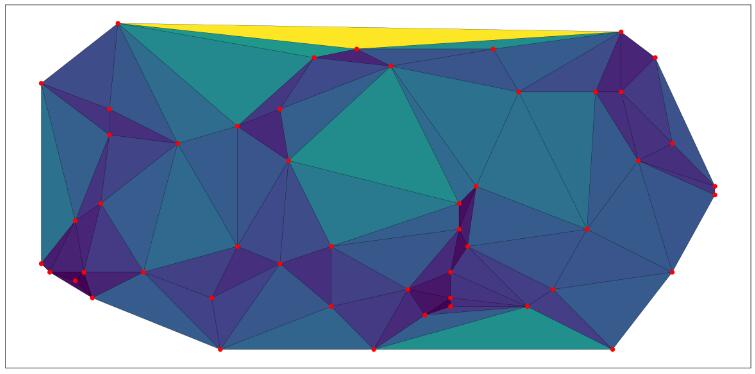
补充:生长算法实现点集的三角剖分( python(tkinter模块))
关于三角剖分
假设v是二维实数域上的有限点集,边e是由点集中的点作为端点构成的封闭线段, e为e的集合。那么该点集v的一个三角剖分t=(v,e)是一个平面图g,该平面图满足条件:
1.除了端点,平面图中的边不包含点集中的任何点。
2.没有相交边。
3.平面图中所有的面都是三角面,且所有三角面的合集是散点集v的凸包。
在实际中运用的最多的三角剖分是delaunay三角剖分,它是一种特殊的三角剖分。
【定义】delaunay边:假设e中的一条边e(两个端点为a,b),e若满足下列条件,则称之为delaunay边:
存在一个圆经过a,b两点,圆内(注意是圆内,圆上最多三点共圆)不含点集v中任何其他的点,这一特性又称空圆特性。
【定义】delaunay三角剖分:如果点集v的一个三角剖分t只包含delaunay边,那么该三角剖分称为delaunay三角剖分。
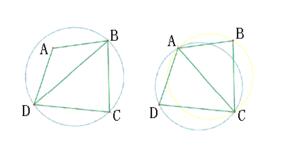
关于delaunay三角剖分算法可以参考百度百科delaunay三角剖分算法
我做三角剖分的目的——构建tin,不规则三角网
不规则三角网(tin)是dem的重要形式之一,相较于规则格网,其具有数据冗余小、细节丢失少的特点。
在分布不规则的高程点之间构建出三角网,其关键技术就是三角剖分
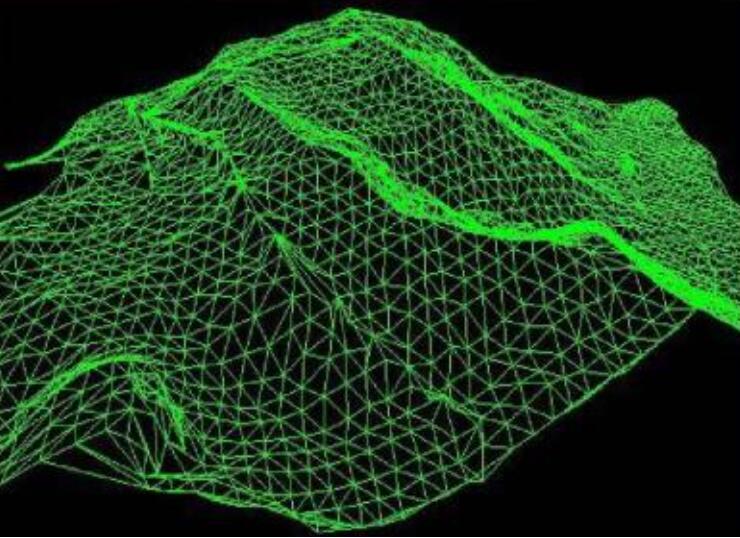
算法步骤
1、首先任选一点,在点集中找出距离改点最近的点连成一条线,以该线为基线。
2、在所有点中寻找能与该基线构成具有空圆性三角形的点,并构成三角形。
3、以新生成的边为基线,重复第二步,直至点集构网完成。
具体代码如下
所使用的python版本为python3.6,编辑器为pycharm2018.3.1
|
1
2
3
4
5
6
7
8
9
10
11
12
13
14
15
16
17
18
19
20
21
22
23
24
25
26
27
28
29
30
31
32
33
34
35
36
37
38
39
40
41
42
43
44
45
46
47
48
49
50
51
52
53
54
55
56
57
58
59
60
61
62
63
64
65
66
67
68
69
70
71
72
73
74
75
76
77
78
79
80
81
82
83
84
85
86
87
88
89
90
91
92
93
94
95
96
97
|
#-*- coding:utf-8 -*-import tkinterfrom tkinter import filedialogimport csv#根据两点坐标计算距离def caldis(x1,y1,x2,y2): return ((x1-x2)**2+(y1-y2)**2)**0.5#输入三角形三个顶点,计算外接圆圆心及半径def calcenter(x1,y1,x2,y2,x3,y3): y1=-y1 #计算公式是根据平面直角坐标推算的,原点在左下角,但是计算机屏幕坐标原点在右上角,所以计算式y坐标取负 y2=-y2 y3=-y3 if (y1 != y3 and y1 != y2 and y2 != y3): #判断是否有y坐标相等,即三角形某边斜率为0的情况,避免出现坟分母为0的错误 if(((x3-x1)/(y3-y1))-((x2-x1)/(y2-y1)))==0: x2=x2+1 x=(((y1+y3)/2)+((x1+x3)/2)*((x3-x1)/(y3-y1))-((y1+y2)/2)-((x1+x2)/2)*((x2-x1)/(y2-y1)))/(((x3-x1)/(y3-y1))-((x2-x1)/(y2-y1))) y=-((x3-x1)/(y3-y1))*x+((y1+y3)/2)+(((x1+x3)/2)*((x3-x1)/(y3-y1))) return (x, -y, caldis(x, y, x1, y1)) elif (y1 == y3 and y1 != y2 and y2 != y3):#若存在斜率为0的边则计算可简化 x=(x1+x3)/2 y=-((x2-x1)/(y2-y1))*x+((y1+y2)/2)+((x2-x1)/(y2-y1))*((x1+x2)/2) return (x, -y, caldis(x, y, x1, y1)) #返回值为元组(圆心横坐标x,圆心纵坐标y,外接圆半径r),计算出来的y值要返回屏幕坐标所以再次取负 elif (y1 != y3 and y1 == y2 and y2 != y3): x = (x1 + x2) / 2 y = -((x3 - x1) / (y3 - y1)) * x + ((y1 + y3) / 2) + ((x3 - x1) / (y3 - y1)) * ((x1 + x3) / 2) return (x, -y, caldis(x, y, x1, y1)) elif (y1 != y3 and y1 != y2 and y2 == y3): x = (x3 + x2) / 2 y = -((x3 - x1) / (y3 - y1)) * x + ((y1 + y3) / 2) + ((x3 - x1) / (y3 - y1)) * ((x1 + x3) / 2) return (x, -y, caldis(x, y, x1, y1)) else: return noneclass gettin: #定义窗口及操作类 def __init__(self): self.path=str() #坐标文件路径 self.pointlist=[] #存放所有点坐标的列表 self.linelist=[] #存放线的列表,每条线用两个点号表示连线 self.tk=tkinter.tk() #定义主窗口 self.tk.title('mytin') self.tk.geometry('1200x720') self.shengzhang=tkinter.button(self.tk,text='生长算法',width=15,command=self.drawtin_shengzhang) self.shengzhang.place(x=1050,y=100) #定义按钮,关联到生长算法计算tin的的函数 self.readin=tkinter.button(self.tk,text='读入坐标文件',width=15,command=self.getfile) self.readin.place(x=1050,y=50) self.can=tkinter.canvas(self.tk,width=950,height=620,bg='white') self.can.place(x=50,y=50) self.tk.mainloop() def getfile(self): #选择坐标文件(*.csv),从文件中读入坐标存入pointlist列表并在绘图区展示出来 self.path=filedialog.askopenfilename() f=open(self.path,'r') fd=csv.reader(f) self.pointlist=list(fd) for i in range(0,len(self.pointlist)): self.can.create_oval(int(self.pointlist[i][0])-2,int(self.pointlist[i][1])-2,int(self.pointlist[i][0])+2,int(self.pointlist[i][1])+2,fill='black') self.can.create_text(int(self.pointlist[i][0])+7,int(self.pointlist[i][1])-7,text=str(i)) def drawtin_shengzhang(self): j = 1 k = 0 mindis = ((int(self.pointlist[0][0]) - int(self.pointlist[1][0])) ** 2 + (int(self.pointlist[0][1]) - int(self.pointlist[1][1])) ** 2) ** 0.5 x = len(self.pointlist) for i in range(1, x): dis = ((int(self.pointlist[0][0]) - int(self.pointlist[i][0])) ** 2 + (int(self.pointlist[0][1]) - int(self.pointlist[i][1])) ** 2) ** 0.5 if dis < mindis: mindis = dis j = i self.linelist.append((k,j)) #首先计算出距起始点(点号为0)距离最短的点,以这两点的连线作为基线开始生长 self.shengzhangjixian(k,j) def drawtin(self): #根据线文件在绘图区绘制出tin for i in self.linelist: self.can.create_line(self.pointlist[i[0]][0], self.pointlist[i[0]][1], self.pointlist[i[1]][0], self.pointlist[i[1]][1]) def shengzhangjixian(self,i,j): #根据某一基线开始生长的函数 x = len(self.pointlist) for k in range(0,x): #遍历没一个点,判断是否与基线构成d三角形 n = 0 #n用于统计外接圆内的点数 if ((k,i) not in self.linelist) and ((i,k) not in self.linelist) and ((j,k) not in self.linelist) and ((k,j) not in self.linelist): for y in range(0,x): #遍历每一个点,判断 if y==i or y==j or y==k: continue if(calcenter(int(self.pointlist[i][0]),int(self.pointlist[i][1]),int(self.pointlist[j][0]),int(self.pointlist[j][1]),int(self.pointlist[k][0]),int(self.pointlist[k][1]))==none): continue else: xyr=calcenter(int(self.pointlist[i][0]),int(self.pointlist[i][1]),int(self.pointlist[j][0]),int(self.pointlist[j][1]),int(self.pointlist[k][0]),int(self.pointlist[k][1])) if caldis(xyr[0],xyr[1],int(self.pointlist[y][0]),int(self.pointlist[y][1])) < xyr[2]: #判断点是否在外接圆内 n=n+1 else: continue else:continue if n == 0: #判断是否为d三角形 self.linelist.append((k,i)) #将新生成的边的端点号加入线列表 self.drawtin() #调用绘制函数绘制tin self.shengzhangjixian(k,i) #以生成的新边作为基线,迭代计算 self.linelist.append((k,j)) self.drawtin() self.shengzhangjixian(k,j) else:continueif __name__ == '__main__': mytin=gettin() |
通过如下代码生成一组随机的点并存入文件
|
1
2
3
4
5
6
7
8
9
10
11
12
|
import randomimport csvfrom tkinter import filedialogpath=filedialog.askopenfilename()outaddress=open(path,'a',newline='')csv_write = csv.writer(outaddress,dialect='excel')for i in range(0,20): x=random.randint(30,920) y=random.randint(30,590) out=(x,y) print(out) csv_write.writerow(out) |
通过上面的程序我们得到一组坐标如下
|
1
2
3
4
5
6
7
8
9
10
11
12
13
14
15
16
17
18
19
20
|
550,43281,334517,265842,408369,123502,169271,425213,482588,24894,295344,350500,385912,527801,491838,455104,479760,160706,77227,314764,576 |
将以上的点在界面中展示出来
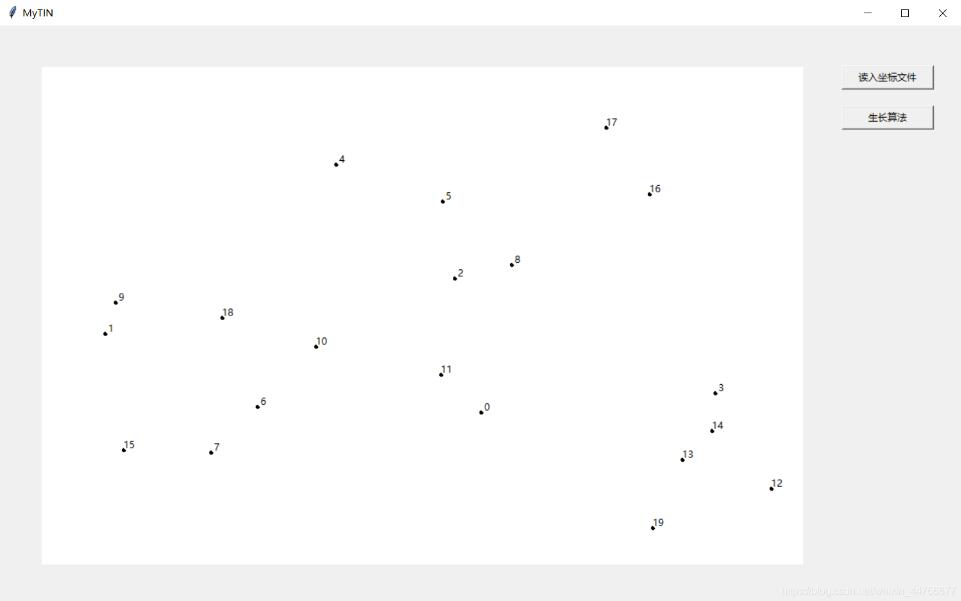
点击生长算法运行得到结果
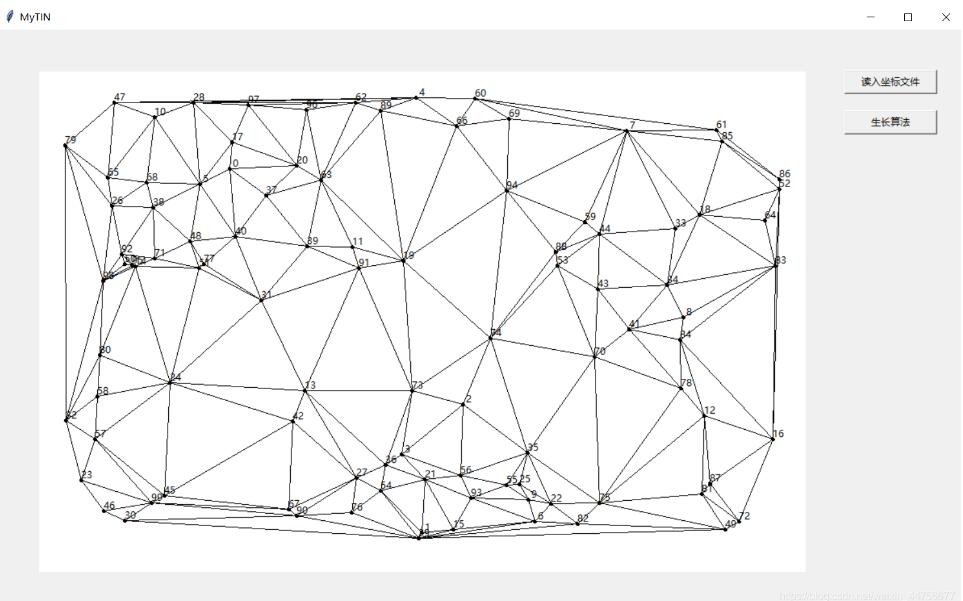
小结
生长算法在三角剖分算法中并不是什么高效的算法,其特点在于算法简单易行,但是计算量大,并且对于新插入的点无法更新,必须重新计算。
相比之下,逐点插入算法虽然计算量仍然较大(似乎三角剖分计算量都不小),但是能实现对新插入点的更新而不用重头计算。
注:文中部分图片及介绍来自百度百科。
以上为个人经验,希望能给大家一个参考,也希望大家多多支持服务器之家。如有错误或未考虑完全的地方,望不吝赐教。
原文链接:https://blog.csdn.net/hpuhjl/article/details/80975599










